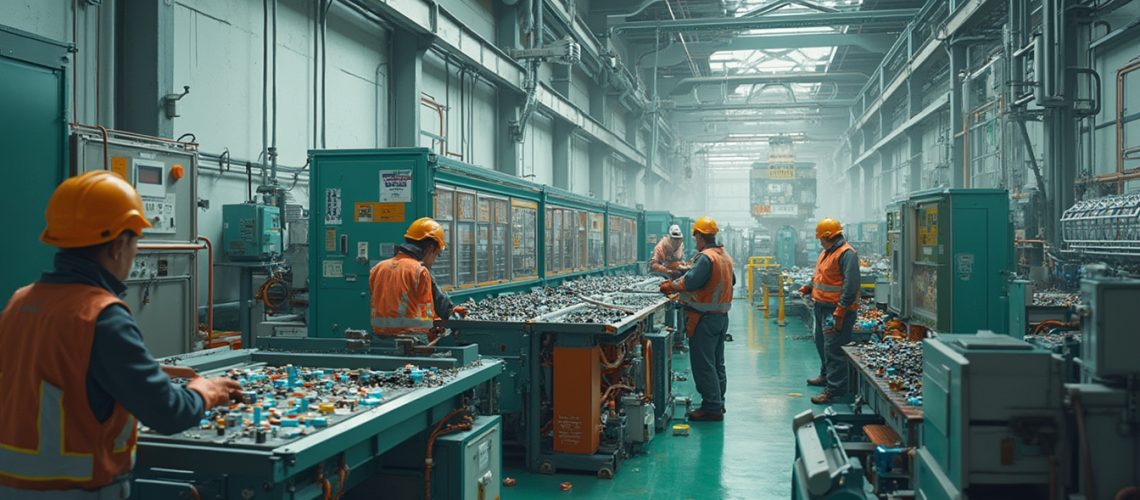Battery recycling in Australia stands at a critical juncture as stakeholders work relentlessly towards levelling up battery recycling in Australia amid rapid technological advancements and strategic investments. The industry is evolving with a focus on developing circular economy practices, reducing electronic waste, and realising the benefits of sustainable energy solutions. These efforts underscore the importance of levelling up battery recycling in Australia by embracing innovative technologies, forging strategic partnerships, and integrating environmentally sound practices.
What is the Current State of Battery Recycling in Australia?
Battery recycling has long been an overlooked component of waste management in Australia. Historically, less than 10% of lithium-ion batteries were recycled, yet recent developments signal a transformative shift. Significant government initiatives coupled with private sector investments have spearheaded a new era aimed at levelling up battery recycling in Australia. For instance, the Australian Renewable Energy Agency (ARENA) played a pivotal role by awarding a $30 million grant to support advanced recycling technologies, including the arena-funded lfp plant, which is a testament to the commitment towards sustainable development.
Furthermore, emerging recovery methods are enhancing the efficiency of recycling processes by utilising cutting-edge innovations like advanced sorting technology that streamline the extraction of valuable materials from used batteries. These combined efforts underscore the drive towards levelling up battery recycling in Australia, creating not only environmental benefits but also new economic opportunities.
How Are Companies Like Envirostream Transforming Battery Recycling?
Companies such as Envirostream have been at the forefront of battery recycling revolution by forging strategic partnerships and deploying unique technological solutions. Through exclusive five-year contracts with industry giants such as ZECO Energy, Hyundai Glovis, and LG Energy Solution, Envirostream is building a comprehensive battery management ecosystem that embraces levelling up battery recycling in Australia.
Their innovative approach encompasses a spectrum of services—from battery sorting and dismantling to discharging and transportation. As Simon Linge, CEO of Livium, aptly observes, "Building out our network allows us to scale the recycling business and create meaningful environmental impact." This sentiment is echoed industry-wide, with initiatives like the green aluminium initiative further bolstering recycling efforts by promoting sustainable manufacturing practices alongside battery recycling.
In parallel, many companies are investing in research and development to refine processing methods. For example, collaborative ventures with academic and research institutions have been instrumental in addressing technical challenges and optimising recovery methods. These efforts help ensure that levelling up battery recycling in Australia isn't just an industrial mandate but also a national priority.
Why is Battery Recycling Critical for Australia's Sustainable Future?
Battery recycling is not merely an environmental necessity; it is a strategic imperative for Australia’s economic and technological independence. As the country increasingly seeks to reduce reliance on imported battery components—especially in light of china's lithium export controls—developing a domestic recycling industry becomes paramount.
The benefits of enhanced battery recycling are multifold:
- Reducing the volume of electronic waste in landfills
- Creating new green technology jobs across the nation
- Strengthening national energy security through resilient supply chains
- Lowering carbon emissions by mitigating the need for energy-intensive raw material extraction
Additionally, levelling up battery recycling in Australia will support sustainable manufacturing, bolster local supply chains, and contribute to a cleaner, more energy-independent future. Analysts have noted that stronger domestic recycling initiatives could lead to a reduction in import dependency and enhance the economic outlook for several interconnected industries. Insights from current mining trends further illustrate how recycling initiatives can stabilise and invigorate the broader resource sector.
What Innovative Technologies Are Driving Battery Recycling Forward?
Innovative recycling technologies are at the forefront of transforming Australia’s electronic waste management and energy strategies. Cutting-edge methods are enabling the recovery of high-value materials, such as lithium and phosphorus, from spent batteries. One notable example is Envirostream’s patented LFP recycling technology, which not only improves recovery efficiency but also minimises environmental impact.
The introduction of automation in sorting and processing has been critical, with recent technological innovations paving the way for fully integrated recovery systems. These include state-of-the-art equipment and processes that allow for more precise separation of battery components. In this context, developments such as advanced sorting technology are proving crucial in maximising material recovery while reducing costs.
Moreover, research initiatives are continually exploring novel recycling methods. The csiro battery recycling program, for instance, contributes valuable insights into energy efficiency and sustainability, facilitating improvements that align with the broader goal of levelling up battery recycling in Australia.
What Are the Key Partnerships Advancing Battery Recycling?
Strategic partnerships are one of the most significant drivers behind Australia’s battery recycling revolution. Collaborations between government agencies, private enterprises, and research organisations have resulted in a multifaceted approach to battery recycling that extends beyond waste management.
Key partnerships include:
- Collaboration between Envirostream and ZECO Energy to ensure the efficient collection and processing of used batteries.
- Strategic alliances with international partners such as Hyundai Glovis to leverage global expertise in sustainable practices.
- Joint investment in research with academic institutions and research bodies, ensuring continual technological evolution and process optimisation.
These alliances also benefit from the support of initiatives like the arena-funded lfp plant, which demonstrates the positive impact of cooperative funding schemes on advancing cutting-edge recycling technology. By pooling resources and expertise, these partnerships help ensure that levelling up battery recycling in Australia becomes a nationwide achievement rather than isolated success stories.
How Will Battery Recycling Impact Australia's Clean Energy Transition?
Battery recycling is set to play a transformative role in Australia's journey toward a cleaner energy future. By establishing efficient and sustainable recycling methods, Australia can not only reduce carbon emissions but also create a robust infrastructure that supports renewable and distributed energy systems.
The environmental benefits extend to several key areas:
- Lowering overall carbon footprints by reducing the need for new battery production
- Supporting the growth of renewable energy storage solutions
- Enhancing local supply chains critical for the sustainability of green energy operations
- Creating a circular economy that recycles materials back into the production cycle
Additional insights from offgrid energy insights show that the rise of lithium battery recycling is intrinsically linked to the broader clean energy revolution. By integrating these processes into the national fabric, Australia can ensure a more resilient and sustainable energy infrastructure—one that is poised for growth in an increasingly eco-conscious global market.
What Challenges Remain in Battery Recycling?
While significant strides have been made, the road ahead for battery recycling in Australia is not without challenges. Some of the most pressing issues include:
- Complex supply chain management:
- Coordinating the collection, transport, and processing of used batteries across vast geographical areas.
- Ensuring a consistent and economically viable feedstock supply.
- Ongoing technology development:
- Continually refining recycling processes to optimise material recovery.
- Overcoming technical hurdles related to battery disassembly and component separation.
- Economic viability:
- Balancing high operational costs with the market value of recovered materials.
- Securing long-term investment and public-private partnerships.
- Standardised collection and processing methodologies:
- Harmonising practices across jurisdictions to ensure quality and efficiency.
- Establishing regulatory frameworks that support industry growth.
These challenges highlight the importance of continued research into innovative solutions, comprehensive policy development, and robust partnerships across sectors. Addressing these issues directly is fundamental to the broader goal of levelling up battery recycling in Australia, ensuring that the industry not only survives but thrives.
FAQ: Battery Recycling in Australia
Common questions about battery recycling include:
-
What types of batteries can be recycled?
Modern facilities can process various battery chemistries, including lithium-ion, lead-acid, and the increasingly popular western lithium ferro phosphate (LFP) batteries. -
How does battery recycling contribute to sustainability?
Recycling reduces hazardous waste in landfills, lowers the demand for raw resource extraction, and supports new, green economic opportunities. -
What are the economic benefits of battery recycling?
Beyond environmental gains, recycled materials can feed back into the manufacturing cycle, driving down production costs, supporting local industries, and contributing to overall energy independence.
As industry leaders, government bodies, and private enterprises work together, Australia is witnessing a remarkable evolution in its approach to battery recycling. The combined efforts not only advance technical innovation but also reinforce the vital objective of levelling up battery recycling in Australia, a mission that promises both environmental rejuvenation and economic prosperity for the nation.
Want to Stay Ahead in the Battery Recycling and Clean Energy Investment Landscape?
Discover actionable opportunities in battery recycling and clean energy with Discovery Alert's real-time AI-driven notifications, which simplify complex market insights and help investors—whether new or experienced—navigate emerging technologies and strategic investments in Australia's sustainable energy sector. Start a 30-day free trial today to transform your investment approach and stay informed about the latest developments in battery recycling and green technology.







